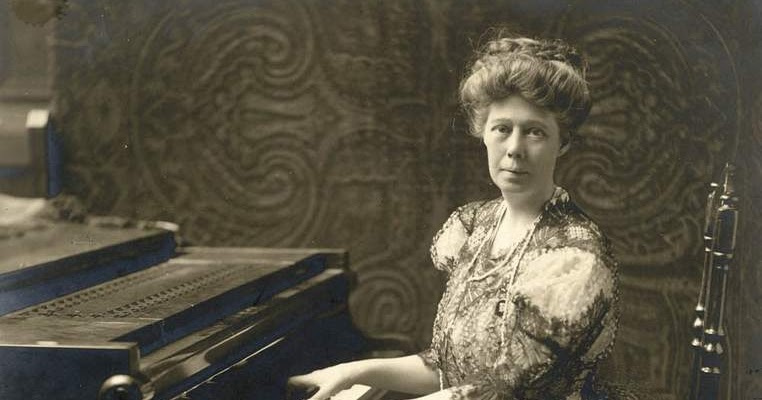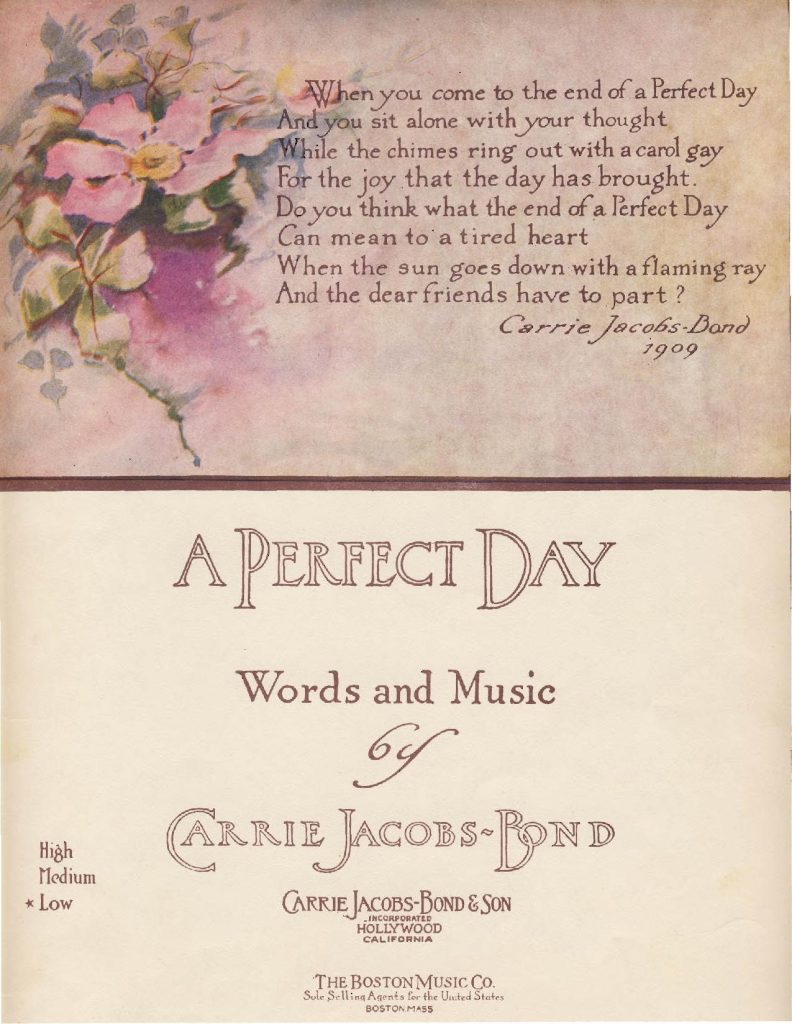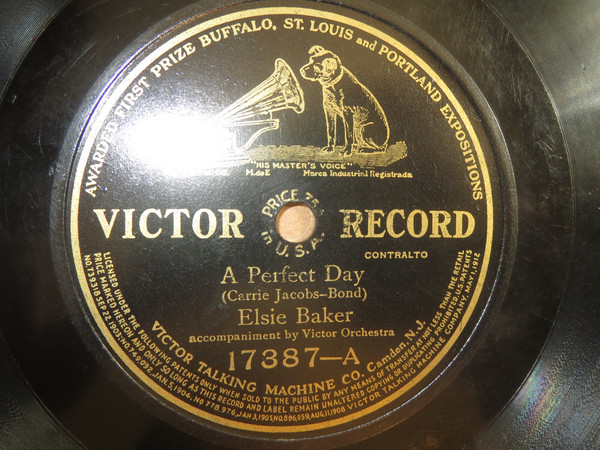“America’s most popular modern song” (The Chattanooga News, 8 Oct. 1930)
“The most popular song ever written” (Hartford Courant, 8 Feb. 1931)
“The most popular song of the 20th century” (Dale Carnegie, 1934)
“The most popular song ever written” (Lawrence Tibbett, 1939)
Seemingly hyperbolic claims for a short song! Yet Carrie Jacobs-Bond’s greatest hit, “A Perfect Day” (1910), was one of the most purchased (sheet music and recordings), most heard (concerts and radio performances), and most sung ballads around the world for decades after it was published. Already by 1922 sales of sheet music were widely reported to have reached 5,000,000, an extraordinary figure. By her death in 1946 five million records had been sold. Because Mrs. Bond wrote the words and music, designed the cover, and also published the song, her profits from this song allowed her to build homes in Grossmont north of San Diego and in the Hollywood hills.

Sometimes termed a “parlor song,” this domestic label, while fitting for 19th-century American popular songs primarily sung in homes, is far too confining for the many functions served by “A Perfect Day.” Often translated, it was performed around the world at weddings, funerals, church services, summer band concerts in the park, civic meetings, conventions, variety entertainments, and films with and without sound. It was sung by men and women in parlors, to be sure, but also by children and adolescents at schools, by amateur and professional recitalists, popular singers and opera stars. More than 200 recordings were made, including performances by Elsie Baker (a top hit in 1913), Alma Gluck, Clara Butt, Rosa Ponselle, Nelson Eddy, Paul Robeson, Webster Booth, Bing Crosby, Mahalia Jackson, and Felicity Palmer. Most remarkably, it was a favorite song of millions of WWI soldiers, sung by both American forces and those of the British Empire as a song that accompanied them on marches, in trenches, and in hospitals (which I will discuss in a later post).
Its popularity seems due equally to the melody and the words. Mrs. Bond wrote the poem for “A Perfect Day” in January 1909 after a day of “motoring” with friends in the hills around Riverside, California, and watching a brilliant sunset from Mt. Rubidoux. The music came to her a few months later, while driving through the Mojave Desert. Remarkably for a hit song of its time, the message is not about love, but friendship, the tone not witty but sincere:
When you come to the end of a perfect day,
And you sit alone with your thought,
While the chimes ring out with a carol gay
For the joy that the day has brought,
Do you think what the end of a perfect day
Can mean to a tired heart,
When the sun goes down with a flaming ray,
And the dear friends have to part?
Well, this is the end of a perfect day,
Near the end of a journey, too;
But it leaves a thought that is big and strong,
With a wish that is kind and true.
For mem’ry has painted this perfect day
With colors that never fade,
And we find at the end of a perfect day
The soul of a friend we’ve made.
From the many signs of the song’s cultural significance, I offer three. Aside from Grant Wood’s iconic painting, “American Gothic,” I can think of few American artworks that have been so often parodied. Here is just one of many rewritings of the poem, published in The Spokane Spokesman-Review (16 February 1935):
When you come to the end of a lollypop,
And you sit alone with the stick,
And you think of the ones in the candy shop
Of which you would like to lick.
Do you think what the end of a lollypop
Can mean to a tired tongue,
When the lollypop is all licked and gone,
And you long for another one?
An enormous sing-a-long testifies to the broad familiarity of the song: in August 1939 a crowd of 90,000 people gathered in Chicago’s Soldier Field stadium, with an additional 8000 performers on the large stage. After hours of performances, and the fall of night, the stadium lights were extinguished and the crowd waited expectantly in the dark, until at the announcer’s prompt, they all lit matches. Then, to mark the 78th birthday of Mrs. Bond, who was present as guest of honor, the assembled throng saluted her by serenading her with “A Perfect Day.” Crowd singing and the illumination of thousands of individual matches and cigarette lighters – these became common at huge rock concerts decades later. But thirty years before Melanie at Woodstock, there was Mrs. Bond at Soldier Field.
This deep connection with the song is the premise of a central scene in the 1940 film, “Remember the Night.” In a farmhouse parlor on the night before Christmas, Sterling Holloway sings “A Perfect Day,” accompanied by the visitor, Barbara Stanwyck. When his family joins in, she tears up, overwhelmed at the end of an emotional day. According to reviews of the time, so too did audiences around the country (Chicago Tribune, 20 Jan. 1940).
To be continued…

Bibliography
On the tenth annual Chicagoland Music Festival (19 Aug. 1939), see Weimar Port, Chicago the Pagan (Chicago: Judy Publishing Co., 1953), 125-26.
The account in the Green Bay Press-Gazette (5 Sept. 1939) estimated the crowd at 105,000.






